#pgm
Explore tagged Tumblr posts
Text
The moon, in a cosmology that takes such a negative view of genesis, can become a threatening presence, a powerful force for harm. The face of the full moon is associated with terror and madness, the gorgon’s head the sight of which can kill or petrify. The moon is the image of Physis, the personification of the material world, and theurgists are warned not to invoke the image of Physis or to look upon her. She is the mother of the daimones that inhabit the material world, the evil spirits who work harm upon the human race. Looking upon the moon or calling on her name brings the powers of genesis, the forces that bind the soul into its body. The moon, is seen not as a helpful intermediary, a necessary step on the way up through the heavens, but as a dangerous power that must be avoided, bypassed with an appeal to beneficent powers of the higher realms, to prevent her from keeping the soul in the dark realm of matter. As the ruler of genesis, the moon is a power whose influence is dangerous and hostile to the soul that is trying to escape from the shackles of fate that bind it to the material world.
"At the Seizure of the Moon: The Absence of the Moon in the Mithras Liturgy", by Radcliffe Edmonds in Prayer, Magic, and the Stars in the Ancient and Late Antique World.
27 notes
·
View notes
Text
"Askion Kataski!" The Ephesia Grammata
Hades 2 players will be familiar with the incantation "Askion kataski!", which Melinoë uses when casting spells at her cauldron.

Hades is relatively good about including references to obscure source material, so I figured that this was probably a real incantation. But I didn't recognize it, and I couldn't find anything on it until recently.
I've been going through The Hekataeon, which, if you don't know, is the best modern grimoire of Hekate magic. It incorporates a lot of historical material, including PGM incantations and traditional folk techniques. Guess what I found:

There it is! As soon as I found this incantation in The Hekataeon, I knew it had to be legit.
It's called the Ephesia Grammata, the Ephesian Letters. It's an example of voces magicae, nonsense or pseudo-Greek words that make up incantations in Greco-Egyptian magic. They're supposed to represent the secret tongue or names of the gods, which enable the magician to call and compel divine forces. The Wikipedia article on the Ephesia Grammata is pretty sparse, but I was able to find some more information on them in my books:
With few exceptions, "mystical" words or formulas do not appear in Greek tablets of the classical and Hellenistic periods, in contrast to the richly variegated language of tablets in the Roman period (first century CE onward). But these exceptions are interesting and important. The first involves a set of six terms, called ephesia grammata, first attested in a fragment of Anaxilas, a comic poet of the fourth century BCE: "(an unnamed person)... carries around marvelous Ephesian letters in sewn pouches. These terms (askion, kataskion, lix, tetrax, damnameneus, and aison/aisia) were believed to possess the ability to endow those who wore them (especially boxers, so it seems) with great power, both defensive and aggressive. They remained well known for centuries, appearing in several later spells and charms. The Christian writer, Clement of Alexandria (ca. 200 CE) not only lists the terms but calls them "famous among many people." More significantly, they appear in at least one lead amulet from the Hellenistic period and thus clearly establish the use of "mystical" terms (voces mysticae) long before their widespread circulation from the first century CE onward. This folded tablet from Crete, dating to the fourth century BCE, must have been carried as a protective amulet (line 20 speaks of protecting the wearer from hostile spells); it contains several of the ephesia grammata: aski and kataski (lines 9-10), lix (lines 5 and 10), forms of tetrax (lines 5, 11-12), and damnameneus (line 16). A second exception is a curious stone monument from Greece, dating to the late fifth century BCE, which Jeffery takes to be a thank offering by an unnamed person for the successful punishment of a personal enemy. She offers the following tentative reconstruction of the text: "The Ephesian vengeance was sent down (?); first Hecate injures (??) the possessions (??) of Megara in all things; then Persephone already is reporting all the (prayers?) to the gods."
— John G. Gager, Curse Tablets and Binding Spells from the Ancient World
TL;DR, the Ephesia Grammata are one of the oldest examples of voces magicae!
Regarding what the words mean, and where they came from:
The most spectacular transformation uncovered by scholars is a set of hocus-pocus words known as the ephesia grammata, which turn out to derive from early hexametrical verses in which the god Paian (Apollo) promises protection from dangers on earth or sea or sky. "Paieon, for in every direction you send averting charms, | and you spoke these immortal verses to mortal men: | "As down the shady mountains in a dark-and-glittering land| a child leads out of Persephone's garden by necessity for milking| that four-footed holy attendant of Demeter,| a she-goat with an untiring stream of rich milk." The first few words of Paian's averting charm, "As down the shadowy mountain" (hossa kata skiarōn oreōn) become aski kataski, while the "goat" (aix) and "four-footed one" (tetrabēmona) become lix and tetrax. These meaningless words, collected together as aski, kataski, lix, tetrax, aision, and damnameneus, are known as the ephesia grammata, probably originally meaning "averting words" (taking ephesia from ephiemi, to avert), but later understood to mean "words from Ephesus." The late lexicon of Photius describes them as incomprensible charms that brought invincibility to an Ephesian wrestler, but also as warding magics (alexipharmaka).
— Radcliffe G. Edmonds III, Drawing Down the Moon: Magic in the Ancient Greco-Roman World.
AFAIK "askios" (ἄσκῐος) also means "shadowless."
The ASKION KATASKION portion only appears once in the Greek Magical Papyri (PGM) a set of Greco-Egyptian magical texts. They appear in PGM LXX 4-25, "Charm of Hekate Ereschigal [sic] against fear of punishment." In this spell, they appear as "ASKEI KATASKEI." The spell instructs the magician to recite the incantation at a crossroads and then flee, "because it is at those places that she [Hekate] appears." So these words are even associated with Hekate specifically!

I didn't personally find any examples of Melinoë's "Kataskion aski!" reversal, but even that reads as authentic, since a lot of voces magicae are palindromic or other variations on a theme.
I am continually impressed by the Hades devs for incorporating stuff like this into the game. They add so much depth and realism to it! This is one of the reasons why Hades is one of my favorite pieces of mythology-related media.
#hades 2#hades game#hades supergiant#ancient greek#ancient greek magic#voces magicae#pgm#greek magical papyri#incantations#magic words
161 notes
·
View notes
Text

Saint-style pendant bearing the image of the lion-headed serpent Chnoubis, a solar gnostic god, sometimes conflated with Abraxas, whose image was used in gemstone talismans of Late Antiquity and the Early Modern period.
The pendant is made from 925 sterling silver.
The back is blank and may be bright, brushed, or hammer finished.
Each piece is hand-made to order in my home studio, with unique variations and defects as a result of the fabrication and casting process.
#Occult Art#Jewelry#Talismanic Jewelry#Art Jewelry#Jewelry Art#Chnoubis#Gnostic#Gnosticism#PGM#Witchcraft#Pagan#Witch Jewelry#Sorcerer’s Workbench
10 notes
·
View notes
Text
The Stele of Aphrodite : an Ancient Greek Love Charm ☆💗☆



Many love spells in the ancient world, particularly in the PGM are that of what are known as fetching charms, or binding spells: love spells targeting specific people. However, there are a number of more generalized love spells, ones with no particular target, such as the Stele of Aphrodite.
The Stele of Aphrodite is Greek Magical Papyri (PGM) spell number IV. 1265-74, and dates back to the late Hellenic period of ancient Greece. It was used primarily for love magic, specifically to invoke the favor and obsession of a desired individual, as well as for favor and success within friendship, popularity and beauty. The stele was believed to harness the power of Aphrodite, the goddess of love and beauty, to sway the emotions and actions of whoever sees you in favor of the practitioner.


Step by step instructions on how to create your own below ☆
Read the full article for free here
#ancient greece#helpol#hellenic polytheism#aphrodite#aphrodite devotee#love spells#love magic#charms#spell tips#spellwork#pgm#greek sorcery#greek gods#greek magical papyri#greek mythology#goêteia#hellenic pagan#ancient history#witchblr
343 notes
·
View notes
Text
i love having books arrive feeling very excited about my new additions to my bookshelf even if it wasn’t the best financial decision
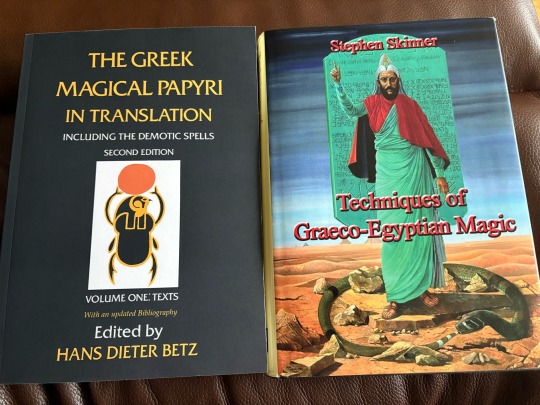
#helpol#greco kemetic#kemetism#greco egyptian magic#PGM#the greek magical papyri#techniques if graeco-egyptian magic#new books#reconstructionist
28 notes
·
View notes
Text
The (Black Cube/Qareen) Shadow Double Binding Ritual



This will be ONLY the ritual procedure, if you want to read the theory of it then I recommend reading the posts below if you need to get an idea on it.
preliminary readings:
Saturn Square spell
Qareen in Arab Magical Literature and the Shadow in Greek Magical Papyri
Appendix to previous post: Shadow/Double as the time-space extension.
When you press read more below it will be JUST the procedure, and there's an assumption that you know what you're doing, accept the risk of it, and have the ability or skill to do this well.
Materials needed:
Frankincense,
Benzoin,
Myrrh
paper doll of person
(kardec) prayer book
Headless Rite written out or printed out
Jar
scissor
Instructions for the paper doll:
The head square will be the saturn square with offset of the person's "lucky number" + the "Black Cube" number calculated.
the chest square would the saturn square offset with the person's lucky number ALONE.
You will cut the head of the paper doll and tape it inside the jar while the body of the doll is taped outside the jar
There's a verse to be written on the neck space and it can be a protective verse from bible or Quran depending on your choice. The left arm of the paper doll will have the Quran verse 37:7, for the right arm it will be an excerpt of the verse 2:255 (وَلَا يَـُٔودُهُۥ حِفْظُهُمَا ۚ) [ and the preservation of both does not tire Him. ] The Legs, left leg will be 19:1 and right leg will be 42:1-2 [حمعسق ]. Now to give an example for the head and body square, let's say that the name of the person is "Sussy Baka" the lucky number for our special guest would be
S u s s y - 103 19 21 19 19 25
B a k a - 15 2 1 11 1
Total is 118.
Now you take the square of Saturn

for the BODY it will be
122 - 127 - 120
121 - 123 - 125
126 - 119 - 124
For the HEAD it will be the same PLUS 60('Black Cube')
182 - 187 - 180
181- 183 - 186
186- 179 - 185
Example Photo:

Baptize the paper doll:
Fumigate the room and the jar(by flipping it over the incense/censer) with Frankincense with Benzoin
recite the prayer "During the Judgement when before the sentence"
Then command the black cube of the person that they're welcome inside the jar, tell them that you want to elevate them and give them a better place.
PRAYER DURING THE JUDGEMENT WHEN BEFORE THE SENTENCE ( from Collection of Selected Prayers by Allan Kardec)
Almighty God. Supreme Justice; Infinite Bondage. In this critical moment I could fail. Your mission is more superior to the sad condition of a mortal condemned to material life by his defects. I humble in front of you with the grave burdens of my defects. I ask your clemency oh! Lord, and the ceremony of God spirits, to help me in this difficult act of my existence. Still in the delayed state of our world we considered it necessary for our social equilibrium. Oh! my God, if in this deserted dwelling, the brother is obliged to judge his brother, because man's law demands it as a duty, your justice is also reflected in them, because this at the same time is a punishment deserved by our miseries and our moral delays. My soul suffers oh! God, feels his brother, and in the necessity to fulfill a duty which will set me in the destiny, I pray to you, oh! celestial Father, I implore your grace, judge me first and with the repentance of my own faults, permit me to elevate myself to your infallible tribune with a pure conscience, and that your radiant light descend over me, and make me see with clarity the fault of he who I condemn, and the causes which make him have trouble with justice. Good spirits, and tutelar angel of mine, do not forsake me; protect also the accused one; let his spiritual guide defend him so that his imprisonment will be less heavy, and let his test be more pleasant to him. Help us all to supplicate our Lord, to give us merit in this life to come to the promised land, and by the betterment of our spirits, only God will be our judge, under whose shelter of infinite bondage we will be protected for eternal happiness.
Exorcise the Black Cube into the jar
Fumigate the jar with myrrh by letting it's face hover over the censer and letting the whole jar get the incense smoke inside of it. pull out your copy of headless rite
start charging the black cube like you're rushing it into the jar to be inside the jar and once you finish immediately close the jar and seal it, you can also wax it
Done!
That's basically the whole procedure and this post almost got me automatically terminated by tumblr's bot for some god unknown reason or something in my blog did it lol, anyway next post will be the actual interview between my volunteer W.F. and his experience after 40 days of having his shadow/black cube sealed into a jar(the one shown above)
#occult#witchblr#magic#ritual#prayer#folk magic#witchcraft#PGM#greek magic#greek magical papyri#arabic occult#arabic magic#conjure#exorcism#ritual magic#ceremonial magic
22 notes
·
View notes
Text
Greek Magical Papyri (PGM) overview videos and online course
Edit: Link updated, they seemed to have deleted their YouTube and moved their videos to their own website!
#hyah!#witchblr#paganblr#witches of tumblr#paganism#spirituality#spiritual#pagans of tumblr#pagan#sorcery#occult#esoteric#PGM#greek magical papyri#archeology#history#ancient history#ancient egypt#ancient greece#magick#resources
38 notes
·
View notes
Text
And when he comes, ask him about what you wish, about the art of prophecy, about divination with epic verses, about the sending of dreams, about obtaining revelations in dreams, about interpretations of dreams, about causing disease, about everything that is a part of magical knowledge.
(PGM I.327–331)
30 notes
·
View notes
Text
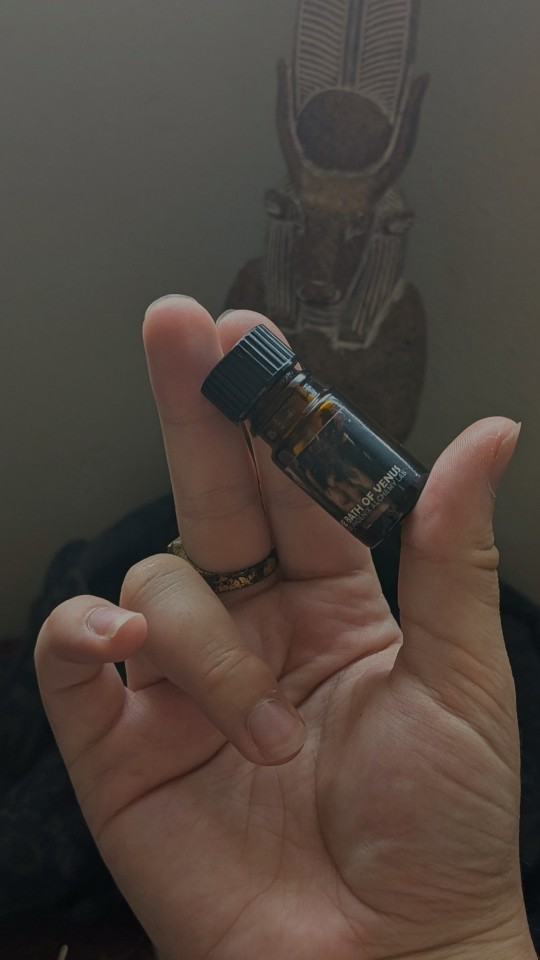
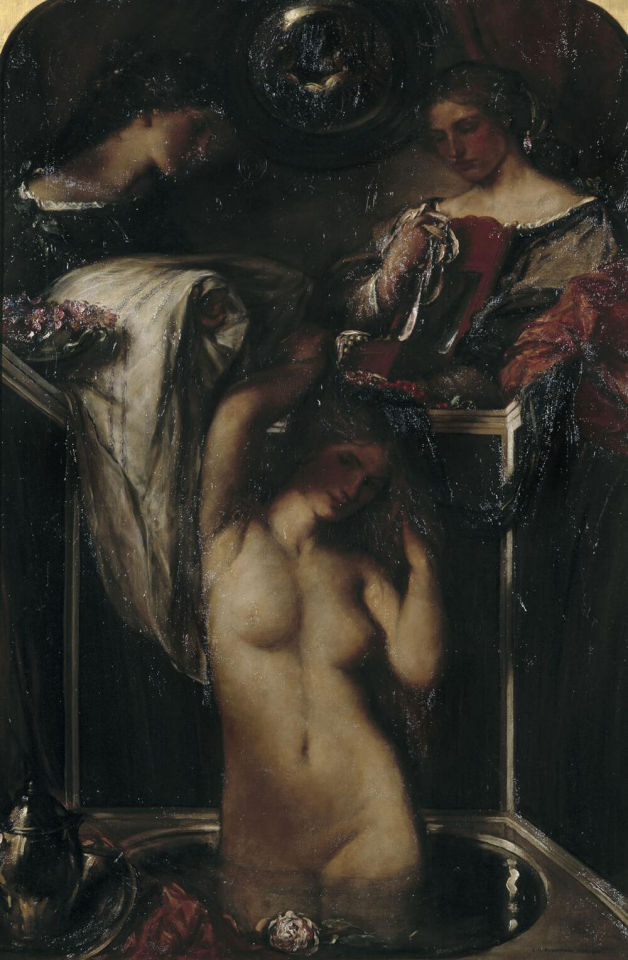
Feeding my new eikon with a favorite perfume of mine, Bath of Venus by Black Phoenix Alchemy. As this will be the centerpiece of my shrine as I work my way through the spells of the PGM, dedicated to She of love and magic, it felt only appropriate to drape her in perfumed scarves and ancestral garnets.
Bath of Venus has become a staple of my glamours and love workings, in no small part because its rich and spiced smell reminds me of Peruvian Agua de Florida if it were steeped in a milky tea. The formula, as described by its chemists:
Velvet rose petals, white silk, red benzoin, sweet black labdanum, honeyed wine, kyphi tar, scarlet amber, and frankincense-smoked carnation petals.
While I adore this potent, Venusian blend, it was a limited stock which has long since sold out. This bottle, my very last, is kept for occasions which demand the utmost Venus energy... Such as honoring a new divinity in Her new shrine.
9 notes
·
View notes
Text
Magical Gemstones: An Abridged Guide
Magical gemstones are a type of talisman made of semiprecious stones —such as hematite, carnelian or amethyst— that were worn set in rings or as pendants and their size ranges from 1.5 cm to 3 cm.These gemstones haven't magical, protective characteristics because of the nature of the gem itself but because the representations of Gods and holy names carved conceded them virtues through holy dynamis: This is, among other things, the inherent power of divine names and/or their representations.
These depictions are normally inverted (negative) This, together with the fact that some of the gems show a certain degree of worn indicates that they were manipulated in some way—probably rubbed or even licked, in order to increase their efficacy—proves that they were not conceived as seals but as amulets or talismans.
A magical gemstone, to be considered as such, should have one or more of the following elements:
An iconographic language generally belonging to syncretic Gods or that combines Gods from different origins.
Charakteres (magical signs. They can be planetary, protective, etc.)
Voces magicae (Words of power and phrases whose formulation and structure may hide secret, sacred names of Gods as well as prayers or incantations dedicated to them, sometimes with the intention of controlling their emanations and daimonēs) and logoi (magical names, permutation of magical names and vocals).
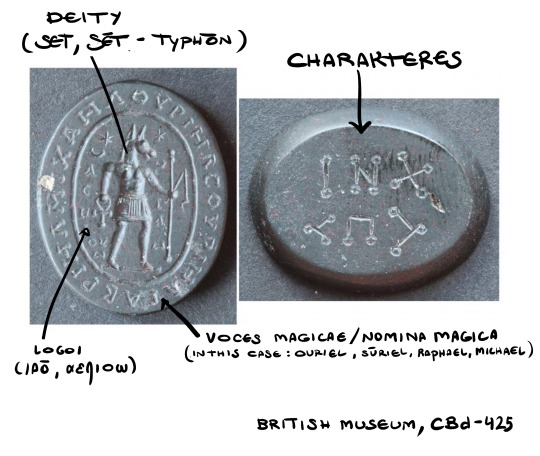
The practice and use of magical voices was transmitted orally across the eastern Mediterranean, but it wasn't until the early 1st century b.c.e. the practice began to be included in written form. The abundance of amulets and gems with magical names and signs are evidence of this change of paradigm.
In addition, elements are usually complemented by two structural features:
The gemstone is engraved on both the obverse and the reverse, sometimes even on the edge.
The inscription appears directly and not in mirror writing.
These magic gemstones, in addition, can be magical gemstones stricto sensu and amuletic gems. The latter differ from the former in:
That the iconographic patterns they contain are explicitly described as belonging to amulets in textual sources such as Posidippus's Lithika
They bear a prophylactic inscription, usually "diaphylasse" (protect me!), "sōzon" (save me!) or "Heis Theos" (One God).
Its production began during the late Hellenistic period, but it was not until the 2nd and 4th centuries c.e. that it reached its apogee. Magical gemstones' imagery demonstrates the diversity and plurality of Greek, Roman, Egyptian, Egyptian, Christian, Gnostic and Jewish representations and ideas from the Mediterranean from the Roman period, as well as the popularity and diversity of magical activities and practices.
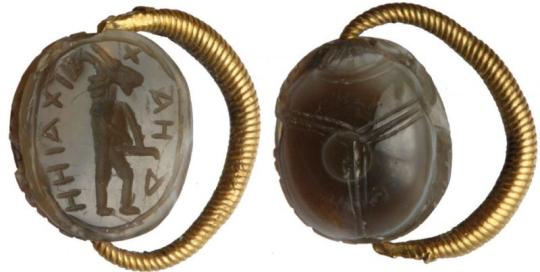
These magic gemstones were rarely used for evil purposes, such as harming someone. Their most common use was to offer protection or solve personal health problems: those showing an ibis tied by an altar and including the command "pésse!" (digest) were used to heal indigestion and other stomach problems; others, depicting a uterus, offered represented a womb, offered protection during childbirth and guaranteed fertility.
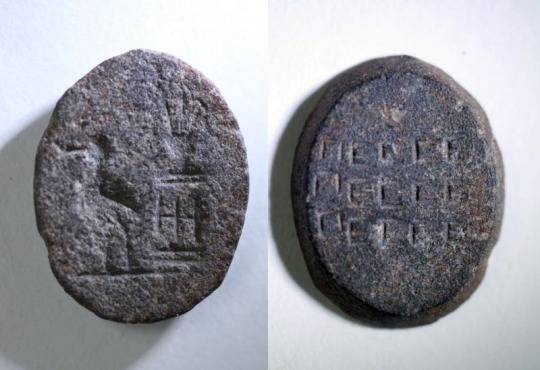

Although most of these magic gemstones were used as jewelry, it is possible that they also had other uses, as part of a ritual to heal a patient or as a physical component for an incantation, such as those with depictions of Harpocrates seated on a lotus the nomina magica Bainchōōōch (Bainchōōōch, Ba of the Shadow, isn't only a vox magica/nomina magica but a God on their own right. PGM aside, Bainchōōōch appears in Pistis Sophia as a triple powered deity that descends onto Jesus, giving him his powers)

An interesting fact is that of the production of magical gemstones during the 17th and 18th centuries of our era. Although the production of these gems continued during the Middle Ages and the Renaissance —irregularly, of course— they reflected the magical and religious reflected the magical and religious practices of their historical context.
This, however, was not the case during the 17th and 18th centuries, where magical gemstones of great quality and sophistication were produced, which not only reproduced the iconographic motifs and logoi of the pre-existing graeco-egyptian magic gemstones, but also introduced new ones. An example of these gems are those with representations of Christ-Osiris or Jesus-Khepri
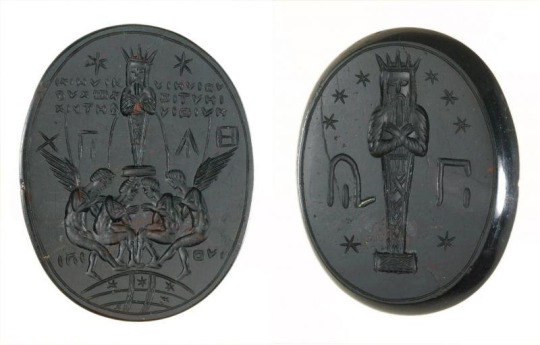
Sources:
Nagy, M. A., (2015) Engineering Ancient Amulets: Magical Gems of the Roman Imperial Period. in D. Boschung and J. Bremmer (eds), The Materiality of Magic (Morphomata 20). Paderborn, 205-240.
Faraone, C. (2018) The Transformation of Greek Amulets in Roman Imperial Times, Filadelfia; University of Pennsylvania Press.
Simone, M., (2005) (Re)Interpreting Magical Gems, Ancient and Modern en Shaked, S., Officina Magica: Essays on the Practice of Magic in Antiquity (IJS Studies in Judaica, vol. 4), Leiden; Brill, 141-170.
Campbell-Bonner Magical Gems Database (http://cbd.mfab.hu)
#magical gemstones#gemstones#PGM#Set#Sutekh#Set-Typhon#Sēt-Typhon#magic#religious syncretism#polytheism#egyptian polytheism#hellenic polytheism#kemetic polytheism#greek magical papyri#Bainchoooch#Thoth#talismans#amulets#talismanic magic
79 notes
·
View notes
Text
PGM MAGIC
I will also make a follow-up post after I've deconstructed the spell and transformed it into a ritual that aligns more with chaos magic
PGM-style incantation for redressing someone—stripping them of ego, illusion, and superiority—compelling them to confront their own errors and place them beneath your dominion. This Greek Magical Papyri (PGM) with layered voice, hieratic language, and apotropaic power. Use within ritual as needed, spoken aloud or whispered over a bound effigy or mirror reflection of the target.
PGM-Style Incantation of Redressive Dominion
To Bring the Flesh to Its Knees and Reveal Its Errors Before the Master
Ἄκουσον, φῦλον τῆς σκιᾶς, ὃς ἀναθαρρῶν φθέγγεται κρίσεις,
οὐκ εἰδώς τὸ βάθος τοῦ ὄντος οὐδὲ τὴν δίκην ὃν οὐκ αὐτὸς ἔγνω.
Hear, you who walk in flesh and shadow,
You who bare teeth in judgment like beasts unbidden,
You whose tongue presumes what truth you have not earned—
I NAME YOU.
I UNNAME YOU.
I REVEAL YOU NAKED BEFORE THE THRONES.
Ⲁϥϣⲁⲓⲛ ⲧⲏⲣⲟ ⲧⲛ̅ ⲙⲉⲧ ⲛⲁⲛ—
“You do not see because you are dust. You speak as though fire shaped you.”
I summon the Binding Breath of the Immortal Ones,
Οἱ Ἄρχοντες οἵτινες ὑποκλίνονται ἐμοί,
The Ones Who Bow to Me in Silence,
Come now and LAY THIS ONE LOW.
Let them bite the dust of their own mouthings.
Let the lie coil back into the throat.
Let their bones ache with the memory of servitude.
Let their mind turn inwards, lost in their own errant ways.
I strip you of the voice you borrowed,
I crush the eyes you stole,
I dissolve the pride that rose without root.
For you are—
Skin without sovereignty,
Voice without verity,
Spirit adrift and claimed.
YOU.
BODY, MIND, BLOOD, BREATH, DREAM—
ARE MINE.
Ἐγώ εἰμι ὁ Κρατῶν.
Ἐγώ εἰμι ὁ Καθοδηγῶν.
Ἐγώ εἰμι ὁ Ἀλήθεια σου.
And you—kneel.
Not as one forgiven,
But as one beheld.
EIE IEŌ PAKERBŌTH LAILAM AIŌN AIŌN
Not as one free,
But as one claimed.
I seal this with the tongue of flame:
IAŌ SABAŌTH ABRASAX ADŌNAI
Turn back your vision inward, beast of clay.
See the rot behind your veil.
Know who holds your breath,
And tremble.
SO IT IS SPOKEN. SO IT IS SEALED.
#PGM#four pillars#arcane#beginner witch#left hand path#lhp#scg witchery#witchblr#witchcraft#gnōsis aei#spellwork#eclectic witch#chaos magick
5 notes
·
View notes
Text
Magic in Ancient Greece: An Introduction
I have seen some people claim that magic or witchcraft did not exist in Ancient Greece. This is not the case. So, I thought I'd take the opportunity to introduce you all to the strange and wonderful world of Ancient Greek magic!
First, what do we mean by "magic"? Radcliffe Edmonds, one of the leading scholars on Ancient Greek magic, defines "magic" as "non-normative ritual behavior." In short, what makes something magic, and not just normal religion, is that people in a given culture think it's weird. The word "magic" itself refers to the magi, Zoroastrian priests — the Ancient Greeks thought they did magic because to them, Zoroastrianism was foreign and weird. They also thought that Ancient Egyptians could do magic for the same reason — what the Greeks thought was spooky magic was just normal religion in Egypt. Within their own culture, magic was basically heteropraxic religion. Magic was not considered hubristic, at least not inherently.
There are multiple Ancient Greek words that refer to magic. The word μάγος, magos, itself means "magician" or "charlatan." There's also γοητεία, goetia, usually translated as "sorcery." The word most often translated as "witchcraft" is φαρμακεία, pharmakeia, the use of drugs or herbs to transform or influence people. This is what Medea and Circe do.
One of our best sources on Ancient Greek magic is the Greek Magical Papyri, or PGM, a set of magical texts from Hellenistic Egypt. When I first learned about it, I thought it was too good to be true, but here it is: uncorrupted ancient pagan magic! Essentially, the PGM is one of the oldest known grimoires, and the ancestor of the entire Western magical tradition. The papyri contain spells and rituals for almost every purpose: curses, love spells, divination, dream oracles, summoning daimones, necromancy, even full mystical rites. Most of them include invocations to various gods, which are heavily syncretic. Helios/Apollo (treated interchangeably) is invoked the most often. Aphrodite appears pretty often, too. Hekate-Artemis-Selene-Persephone (conflated with a whole bunch of other chthonic goddesses, including Ereshkigal) has her own set of spells. You'll even find the names of Egyptian gods and Hebrew angels in there.
One of the most common features in PGM spells is voces magicae or barbarous names, nonsense words that are supposed to be the secret names of the gods, which give you the authority to call them up. They act almost like a written form of glossolalia. Most are supposed to be spoken or chanted aloud. Some sound like actual names, or are well-known magical epithets like ABRASAX. Some are just strings of Greek vowels. Some of them are palindromic; there's lots of spells that use the "abracadabra" disappearing-letter-triangle format. There's also charakteres, apparently-meaningless magical symbols, the distant ancestor of modern sigils.
Another major source for Ancient Greek magic are defixiones or katadesmoi, curse tablets. They're little lead leafs called lamellae, which are inscribed with curses and then deposited in wells, graves, and other chthonic places. Thousands of them have been found.

Here's the text of a curse tablet that invokes Hekate and Hermes Kthonios (copied from Curse Tablets and Binding Spells from the Ancient World by John G. Gager):
Hermes Khthonios and Hekate Khthonia Let Pherenikos be bound before Hermes Khthonios and Hekate Khthonia. I bind Pherenikos’ [girl] Galene to Hermes Khthonios and to Hekate Khthonia I bind [her]. And just as this lead is worthless and cold, so let that man and his property be worthless and cold, and those who are with him who have spoken and counseled concerning me. Let Thersilochos, Oinophilos, Philotios, and any other supporter of Pherenikos be bound before Hermes Khthonios and Hekate Khthonia. Also Pherenikos’ soul and mind and tongue and plans and the things that he is doing and the things that he is planning concerning me. May everything be contrary for him and for those counseling and acting with…
Another curse tablet, which invokes Hekate to punish thieves, includes a drawing of her and charakteres. This is how she's depicted:

From Curse Tablets and Binding Spells in the Ancient World by John G. Gager
It's supposed to be a woman with three heads and six raised arms, but to me it looks like Cthulhu, which is honestly appropriate.
There was a very fine line between love spells and curses in Ancient Greece. Some love spells in the PGM call upon the spirits of the dead and chthonic gods to torture a poor girl until she submits to the magician. Just as many defixiones attempt to forcefully bind a lover. But there's another, gentler kind of love spell described by Theocritus in Idylls, in which a witch named Simaetha invokes the Moon and Hekate and uses an iynx wheel to make a man love her.
If you want to know how to apply all of this in modern practice, I'm still working that one out. I've found the PGM very hard to adapt, because a lot of its requirements are dangerous or impractical. Many of its spells require gross ingredients worthy of the Scottish play, or plants that scholars can't identify, or procedures that I don't plan on attempting. And if you haven't noticed by now, most of them fly in the face of modern magical ethics. (Don't let anyone tell you that the gods will punish you for doing baneful magic, because that's clearly bullshit.) On the other hand, Crowley adapted his Bornless Ritual almost word-for-word from PGM V. 96—172. So far, the best resource I've found on modernizing Ancient Greek magic is The Hekataeon by Jack Grayle. Its material is clearly historically-inspired, but still doable, and spiritually relevant. I really recommend getting it if you have the means, especially if you have an interest in Hekate specifically. I'm happy to have it as a model for how to adapt ancient magic for myself in the future. To me, it strikes the perfect balance between historically-informed and witchy, which is right where I want to be.
If you can't access that one, here's some other books I recommend:
Drawing Down the Moon: Magic in the Ancient Greco-Roman World by Radcliffe G. Edmonds III: An introduction to Ancient Greek magic, both scholarly and accessible. It covers the definitions and contexts of magic, curses, love spells, divination, theurgy, philosophy, basically everything you need to know.
The Greek Magical Papyri in Translation by Hans Dieter Betz: The definitive English edition of the PGM. A must if you plan to study ancient magic in-depth, especially as a practitioner.
Curse Tablets and Binding Spells in the Ancient World by John G. Gager: An English edition of the texts of many curse tablets.
Magic, Witchcraft, and Ghosts in the Greek and Roman Worlds by Daniel Ogden: a sourcebook of ancient literature concerning magic.
The Golden Ass by Apuleius: A Roman novel about a man who is turned into a donkey by a witch. A very entertaining story, also our source for "Cupid and Psyche" and one of the best sources on the Mysteries of Isis that we have.
Ancient Magic: A Practitioners Guide to the Supernatural in Ancient Greece and Rome by Philip Matyszak: A simple and straightforward introduction to Ancient Greek magic, less scholarly but very easy to follow and directed at practitioners.
#occultism#occult#ancient greece#ancient magic#folk magic#pgm#greek magical papyri#curse tablets#helpol#hellenic polytheism#hellenic paganism#hellenism#magic#occult history#history#ancient greek history#book recommendations#hecate#hekate
362 notes
·
View notes
Text
Reading the Hermetica: Initiatic Rituals in the Greek Magical Papyri
For this week’s Reading the Hermetica discussion, we’re continuing our look at technical Hermetic texts such as we might find in the Greek Magical Papyri (PGM) and focusing on several that tackle initiation rituals: I.1—42, I.42—195, IV.154—285, XIII (as a whole), and IV.475—829. For this, you should get yourself a copy of Betz’ The Greek Magical Papyri in Translation. As an alternative to…
#betz#calling the sevenths#eighth book of moses#mithras liturgy#paredros#pgm#pgm xiii#reading the hermetica#supernatural assistant#tenth book of moses
4 notes
·
View notes
Text
"I know everything about ancient Egyptian theology" okay bet

#ancient egypt#egyptology#egyptian mythology#theology#ancient history#meme#iceberg#deep dive#Omphûr#sutekh#the headless one#greek magical papyri#pgm#puramid texts#Hatayw#demons#book of the dead#witch community#cannibal texts#asklepios#Greco-Egyptian polytheism#polytheist#netjeru#ma'at#execration
213 notes
·
View notes
Text

Michael Jordan, 2011 Fleer Retro Precious Metal Gems (Red)
#Michael Jordan#PGM#Precious Metal Gems#2011 Fleer Retro#Metal Universe#PSA#Basketball#Basketball Cards#Chicago Bulls#UNC Tar Heels#North Carolina#Insert Cards
3 notes
·
View notes